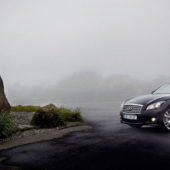Doctor Nikolaus Eberl is the author of the bestselling book BrandOvation: How Germany won the World Cup of Nation Branding, and the sequel The Hero’s Journey: Building a Nation of World Champions. Dr Eberl’s research study on Germany’s nation branding success story during the 2006 FIFA World Cup was featured extensively on TV, especially on Carte Blanche TV show, and as consequence he is currently engaged in internal branding for the 2010 FIFA World Cup, which will take place in South Africa. In this large article we consolidate several articles by him which circundate about South Africa’s nation branding prospects.
The state of the nation’s brand
In his State of the Nation Address, President Kgalema Motlanthe said South Africa must use the 2010 FIFA World Cup to showcase the humanity of the country and the entire continent. Given the immeasurable price tag of the 2010 branding opportunity, what are the drivers for transforming the national and continental brand image?
Said Motlanthe, “The true legacy of the event will be in our ability to showcase South African and African hospitality and humanity – to change once and for all perceptions of our country and our continent among peoples of the world. That depends on all of us, and to that we can attach no price.”
At the recent Chief Marketing Officer (CMO) Council meeting held in Seoul, Korea, the global state of nation branding was reviewed. The CMO Council is a global channel, representing 3500 CMOs that control in excess of US$120 billion in annual marketing spend.
In his presentation on nation branding, the founder and executive director of the CMO, Donovan Neale-May, reviewed how products or programmes reinforce and stand for nation brand characteristics, such as Switzerland’s banking system for confidence and reassurance, Norway’s Nobel Prizes for relevance and influence, Finland’s mobile technology ingenuity for skill and capability, Sweden’s furniture for contemporary, clean and functional design, and Canadian Mounties for trust and integrity (which was most recently reinforced by a World Economic Forum survey that proclaimed Canada to have the world’s soundest banking system).
Which products stand for and reinforce Brand South Africa, whose brand essence is “to inspire new and different ways”? And where in the global landscape of nation brands does Brand SA currently fit in?
Interestingly, Neale-May placed South Africa in the second highest category of nation brands, as he segmented country brands into the following four categories:
- Four Star Nation Brands that are “established, stable and well-defined”, such as the UK as perceived by financial services and wealth management, Germany as per electronics, construction and engineering, and France for fine food, fashion and cosmetics;
- Three Star Nation Brands that are “emerging, evolving global contenders”, such as India as per business process outsourcing and IT integration, Brazil in terms of agriculture and eco-zone management, and South Africa as per gold, diamonds and wildlife experiences;
- Two Star Nation Brands that are “challenged, complex and controversial”, such as Russia for energy, commodities and energy, China for manufacturing and infrastructure development, and Israel for military technology and intellectual capital;
- One Star Nation Brands that are “ill-defined, under-valued and asset-rich”, such as Argentina as per beef, football, spectacular scenery, Korea for heavy industry, electronics and mobile technology, and Turkey as in music, belly dancing and coffee.
Asked what makes a nation brand stand out, Neale-May pointed to the imperative of creating “a defined and differentiated experience”, based upon the unique “cultural fabric, mindset, attitudes and values” of the respective country – this boding well for the key differentiator of Brand SA, which is “to inspire the world to a new way of doing things because our unique combinations create refreshing possibilities.”
Transforming South Africa’s brand image
Of the two drivers that Motlanthe pinpointed for transforming South Africa’s brand image post 2010, hospitality and humanity, the former – contrary to popular perception – ranks well amongst foreign visitors. The 2007 Annual Report on Tourism South Africa identified customer service as the third best experience of tourists, only to be superseded by the experiences of scenic beauty and visiting family and friends. In fact, only 2.1% of all foreign tourists surveyed in 2007 cited poor service as their most negative experience. The same survey identified ‘hospitable and friendly people’ as the second highest driver of visitor satisfaction, second only to the natural attractions.
However, a global survey on “Government Leadership in Customer Service”, conducted across 124 countries in 2007, ranked South Africa 111th. Assessing levels of service delivery by Government, the report (which was misreported in the local tourism media for addressing service levels in the tourism sector) showed that “South Africans are highly dissatisfied with the service they currently receive” – a sentiment that was echoed by Motlanthe in his State of the Nation address, when he said, “much more needs to be done to improve the service culture and orientation of some public servants, especially those at the coalface of direct interaction with the public.”
As for foreign visitors to South Africa, the single most negative experience reported was safety and security, ranging from petty theft to serious contact crime, and, as many other surveys have evidenced, this is the single most damaging perception, both domestically and internationally, to South Africa’s brand image.
At a recent media leadership seminar in Johannesburg, Germany’s sports journalist of the year, Jens Weinreich, concluded his address by stating that “if I try to summarize the German media coverage of South Africa, I have the impression that it is dominated by five points: violence, violence, violence, corruption, and political instability. I do think it will influence the tourist sector in advance and during the World Cup.”
With just 484 days to go to the World Cup kickoff, these two factors – service delivery and safety and security – are the ultimate determinants of whether we will be able to make Motlanthe’s prediction come true – “to change once and for all perceptions of our country and our continent among peoples of the world.”
The example of Germany
When the 2006 FIFA World Cup in Germany was summarized by FIFA’s Joseph Blatter, he stated, “This was the best World Cup of all time. Never before has such an event been presented in such an emotional and global manner.” In order for South Africa to follow the example of Germany and deliver the best World Cup ever, the country needs to analyze the 7 key pillars to Germany’s re-branding success:
- Delivering the brand promise
- Having a winning team
- Maximising brand yield
- Ensuring visitor safety
- The invention of ‘partyotism’
- Client centricity
- Gender equality
Eberl says, “Apart from soccer, the 2006 FIFA World Cup transformed Brand Germany from the old archetype of the Ruler – effective and efficient, yet cold, unfriendly and sometimes a bully – to the newfound archetype of the Lover – fun-loving, welcoming, modern and creative. In a few weeks’ time, it had done something to the German psyche that no politician had ever achieved: it had imbued the nation with a sense of pride and common destiny. On the day after the final, Britain’s Times, not known for being pro-German, ran the headline ‘Never mind the Finals, the true Winners are Germany’.”
According to Eberl, South Africa must – and can – grasp the opportunity provided by the 2010 FIFA World Cup to do the same, given that the Nation Brand Index (Anholt-GMI Q4/2007) ranks the country 29th out of 37 nations, which shows that South Africa’s brand promise ‘Alive with Possibility’ is not delivered optimally to investors and visitors alike. “With all the attention focused on stadia construction at the moment, it is crucial to remember that ultimately it is not the packing that creates a lasting impression, but rather the product. Nation branding, much like Personal Branding, is to a large extent dependent upon the self-image of its main character, in the case of nations this being the citizens. The 2006 FIFA World Cup boosted the national German psyche and bestowed Germans with the long lost emotion of national pride and self-confidence. For 2010 to do the same for the South African psyche, a national Brand Pride Campaign is required that is aimed at transforming the soul, not the looks, of the country.”
South Africa can be Sydney or Beijing
Not only the FIFA World Cups provide experience on branding a nation through a sports event. The Olympics, of course, are also a primary source of experiences. The 2000 Sydney Olympics, for instance, is said by the head of Australia’s tourism authority to have advanced that country’s international tourism brand by a decade. Can South Africa achieve the same result with 2010?
As the global credit crunch takes its toll on international tourist arrivals, with some destinations such as India reporting that inbound traffic has declined by almost 20%, it has become critical to shift gears in attracting visitors to our shores and intensify the marketing efforts for 2010. This begs the question, what are the benchmarks for leveraging international sport events for maximum tourism benefits? Which previous hosts stand out as possibly best-in-class – and which ones are examples to avoid?
At the forefront of global contenders for best-leveraged-event, are the 2000 Olympics hosted by Sydney, which then IOC President, Juan Antonio Samaranch, declared “the best ever”, and Australia’s Olympic tourism strategy has been hailed by industry experts as a role model for future host cities.
It was the IOC’s director of marketing, Michael Payne, who suggested that “Australia is the first Olympic host nation to take full advantage of the Games to vigorously pursue tourism for the benefit of the whole country. It’s something we’ve never seen taken to this level before, and it’s a model that we would like to see carried forward to future Olympic Games in Athens and beyond.”
On the heels of the Sydney closing ceremony, the Managing Director of the Australia Tourist Commission (ATC), John Morse, stated that the Games changed forever the way the world sees Australia and that the country’s international tourism brand had been advanced by 10 years.
The ATC’s four-year Olympic strategy focused on promoting Australia through an intensive media relations program. By working with the world’s leading broadcasters, the ATC managed to turn the Olympics into a two-week documentary on all aspects of Australian life. For instance, the UK’s leading travel show, The Holiday Program, focused its tenth anniversary program in 1999 on Australia, featuring its cities as well as its people.
Further, ATC teamed up with Visa to promote Australia and the Games in a move that turned out to be the most effective PR campaign of modern Olympics. The logo Australia prefers Visa was seen all over the world in all forms of media and reached millions. In another partnership, US Broadcaster NBC agreed to promote Australia by linking Brand Australia with the Olympic brand by the colours of the Olympic Rings. This ensured Australia was seen as a “vibrant, friendly, colourful, free-spirited place that offers a sophisticated lifestyle”.
The success of Australia’s tourism branding campaign was reflected in the steady rise of Brand Australia in the Nation Brand Index over a period of five years. Says Simon Anholt, the author of the NBI: “What this tells us is that much of the world has an appetite for things Australian. Now is the time for Australia to be producing great Australian-branded products, culture, events, services, ideas, and media as fast as it possibly can. Anything that reflects, promotes and sustains those essential and admired Australian values will sell.”
On the contrary , hosting the 2008 Olympics appears to have done little for China’s tourism brand. According to a recent poll carried out by GlobeScan for BBC World Service, global attitudes towards China are worsening. China’s positive ratings have fallen six points over the year – to 39%.
“Our poll results suggest that China has much to learn about winning hearts and minds in the world,” said GlobeScan chairman Doug Miller. “It seems that a successful Olympic Games has not been enough to offset other concerns that people have.” This is despite spending more than US$400m on the lavish opening ceremony and scooping up the biggest medal tally of all nations participating in the 2008 Olympics.
Other than Australia, China did not use the Olympics to proactively promote inbound tourism, but rather focused on sanitizing the event and using it as a platform to demonstrate her logistical and organizational prowess. As a result, the nation brand index notes that “tourism appeal in China is lagging. People are showing no increase in their desire to visit China, despite the undoubted fascination of its historical heritage. In fact, the trend in China’s results for “likely to visit, money being no object” is the worst of any country – a drop of 5.6% since late 2005. China has sunk to the 27th position in the tourism brand rank.”
If there is one lesson from previous hosts, that sets a memorable event apart from an average one, it is Anholt’s conclusion of branding sporting events: “The event gives the country permission to make one single, clear, striking point about itself; and if the only point it manages is its ability to run an event competently, or that it has money to burn on new facilities and lavish opening ceremonies, then by the time the next host takes over – or even sooner – the world will have forgotten that the event ever took place.”





Germany nation branding